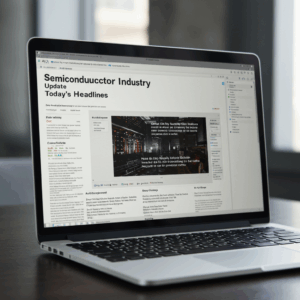Introduction.
This week in the AI industry has been extremely dramatic, with a mix of **”enthusiastic investment” and “market skepticism “**.
With NVIDIA surpassing $5 trillion in market capitalization for the first time in history and the announcement of the construction of one of the largest AI supercomputers in the U.S., large-scale infrastructure investment continues to accelerate. On the other hand, the U.S. stock market has begun to take a hard look at realistic business value creation, with AI-related stocks plunging and market uncertainty about OpenAI’s funding.
This article takes an in-depth look at the major AI-related news stories of the first week of November 2025 (November 2-8) and examines their specific applicability, particularly what the manufacturing industry should learn from these developments and how it can become more competitive.
📰 Summary of key news: Read about the impact on manufacturing
1. accelerating large-scale investment in AI infrastructure: democratizing high-performance computing
- NVIDIA and Oracle Build Largest AI Supercomputer in the U.S. NVIDIA and Oracle have announced that they are building the largest AI supercomputers in history, Solstice and Equinox, for the U.S. Department of Energy (DOE), totaling 2,200 exaflops. The computers are expected to be operational in early 2026 and will accelerate medical, materials science, and energy research.
- Implications for manufacturing: If this type of high-performance AI infrastructure is delivered through cloud services, simulation of new material development andcomplex product design optimization, previously accessible only to large corporations, could become affordable to small and medium-sized manufacturers.
- On November 1, NVIDIA became the first company in history to reach $5 trillion in market capitalization, driven by surging demand for AI. The company is leading global AI infrastructure deployment, including a contract to supply more than 260,000 Blackwell AI chips to South Korea.
2. strategic alliance between SoftBank and OpenAI: penetration of AI agents into corporate management
- Establishment of Joint Venture SB OAI JapanOn November 5, SoftBank Group and OpenAI announced the establishment of a joint venture company, Crystal Intelligence, to localize OpenAI’s enterprise technology for the Japanese market.
- Implications for the manufacturing industry: Softbank’s own case study of implementing AI agents to try to create proposal materials and optimize business processes provides a concrete path for AI to support management decision-making anddramatically improve the efficiency of back-office operations.
3. Tesla’s Plan to Manufacture AI Chips In-House: Vertical Integration and Custom AI Advantages
- Tesla Plans Giant AI Chip Factory On November 6, CEO Elon Musk mentioned the need for a “giant chip factory” to manufacture AI semiconductors and suggested a possible partnership with Intel. The fifth-generation AI chip, AI5, is expected to consume one-third the power of NVIDIA’s Blackwell and cost about 10% less to produce.
- Implications for Manufacturing: This trend of vertical integration in automotive manufacturing strongly suggests to the manufacturing industry as a whole that in-house development and manufacturing of custom AI semiconductors optimized for specific applications could provide future cost competitiveness and performance advantages.
4. the rise of skepticism about the AI market: the era of ROI-oriented
- Reports of a Nearly $1 Trillion Tech Stock Sale and Market WorriesOn November 7, a mood of skepticism replaced the AI-related frenzy and the stock prices of giant tech companies plummeted. The move reflects doubts about the sustainability and actual business value creation (ROI) of AI investments.
- Implications for the manufacturing industry: The report warns against short-term fads and calls for a more pragmatic approach to AI implementation, with a clear return on investment (ROI) and practicality as the top priorities.
5. McKinsey Global Survey “The State of AI 2025”: Workflow Redesign Key to Success
- Organizations Using AI Increases to 78%, Generated AI Use Increases to 71%According to McKinsey’s survey (released November 5), 78% of all organizations are using AI and regular use of generated AI has increased significantly to 71%. The most important finding is that “workflow redesign” is the factor that has the greatest impact on EBIT (earnings before interest and taxes) impact from generative AI.
- Implications for the manufacturing industry: It is not enough to simply “stick” AI tools into existing operations; a fundamental review of the entire business process based on the assumption that AI will be used is an absolute prerequisite for maximizing the revenue impact.
🏭 Applications and considerations for manufacturing: establishing competitive advantage
1. strategic use of AI infrastructure: breakthroughs in product development
The democratization of high-performance computing raises the bar for simulation and analysis in manufacturing.
- Accelerate material development: AI takes charge of simulations for predicting the properties of new materials and optimizing formulations, significantly shortening development time.
- Gartner predicts that by 2025, more than 50% of manufacturers will integrate AI into their quality control processes, increasing defect detection by 30%. AI infrastructure development is directly linked to competitiveness.
2. generation AI and workflow reform: Fundamental redesign of operations
As the McKinsey study indicates, “workflow redesign” is essential to maximize the benefits of implementing generative AI.
- Streamlining the design and development process:
- Automatic generation of technical documents: AI automatically drafts design specifications and manufacturing instructions.
- Automatic generation of drawings from CAD data: Automatic generation of 2D drawings including machining instructions from 3D models to reduce manual work.
- Decision support for manufacturing sites:
- Optimization of real-time production planning: Demand forecasts, inventory, and equipment utilization rates are centrally analyzed to automatically generate optimal work instructions.
- Advanced quality control:
- Automatic inspection by image recognition: Replaces visual inspection with more than 90% accuracy ( see SpectroGen tool from MIT and GM case studies ).
- Predictive Quality Control: Predicts defect occurrence based on manufacturing parameters and immediately makes process adjustments.
3. vertical integration and custom AI development: learning from the Tesla model for competitive advantage
Tesla’s strategy of developing its own dedicated AI chips encourages a move away from commodity solutions.
- Customized edge AI devices: Develop dedicated hardware for low power consumption and high-speed processing, such as image recognition chips specifically designed for manufacturing lines.
- Build an industry-specific AI model: Build a proprietary AI system that encodes your company’s past data and expertise to create a differentiating factor from your competitors.
- Building an AI ecosystem: promote data sharing and AI utilization throughout the supply chain, with a view to joint development with collaborating companies.
4. governance and organizational structure for AI implementation: CEO-level commitment
McKinsey research shows that revenue impact is highest in organizations where the CEO oversees AI governance.
- Establishment of AI promotion system: An AI Strategy Committee was established by management and cross-functional promotion teams were formed.
- Risk Management and Compliance: Strengthen compliance with ongoing AI regulations in various countries, including India’s proposed AI labeling regulations.
- Human Resource Development and Skill Transformation: In addition to aggressive hiring for AI-related positions, reskilling of existing employees will be implemented company-wide.
📊 Future Prospects and Challenges
| Fields | Short-term Outlook (to 2026) | Medium- to Long-term Outlook (after 2027) |
| Technology | Practical application of agent-based AI, further enhancement of cloud-based AI services | Fully autonomous manufacturing systems, integration with quantum computing |
| Market | Accelerating Diffusion of AI Infrastructure and Increasing Price Competition | Diffusion of mass customization, integration of sustainability and AI |
| Challenges | Lack of human resources (especially data scientists), ensuring data quality | Security risks (exploitation of AI by attackers), compliance with international regulations |
Summary: AI is already a source of competitive advantage
AI trends for the first week of November 2025 suggest that while the pace of technological evolution continues unabated, the time has come to shift the focus of investment to “real benefits”.
The following five points are essential for manufacturers to successfully implement AI and establish a competitive advantage
- Clear commitment and strategy formulation by top management.
- Fundamental redesign of the entire workflow (not just tool implementation).
- Small start and phased deployment based on realistic ROI assessment.
- Ongoing human resource development and reskilling.
- Creating an ecosystem involving the entire supply chain.
AI technology has already entered the practical stage, and over the next few years there will likely be an unbridgeable competitiveness gap between companies that can strategically utilize AI and those that cannot. The future of the manufacturing industry depends on the pursuit of AI applications that truly contribute to solving its own problems, without being distracted by trends.
📚 List of sources
- NVIDIA News – “NVIDIA and Oracle to Build US Department of Energy’s Largest AI Supercomputer” (October 28, 2025 )
- The AI Track – “Nvidia Becomes First Company to Hit $5 Trillion Valuation” (November 1, 2025)
- SoftBank – “SB OAI Japan, a joint venture between SoftBank Group and OpenAI” (November 5, 2025).
- Reuters – “Tesla plans giant AI chip factory, partners with Intel = Musk” (November 7, 2025)
- McKinsey & Company – “The State of AI: Global Survey 2025” (November 5, 2025)
- Medium – “This Week in AI: November 3, 2025” by André Bergholz (November 3, 2025)
- Bloomberg – “AI Frenzy Unusual, Market Worried About OpenAI Funding – ‘Government Guarantee’ Speculation” (November 7, 2025)
- MIT News – “Checking the quality of materials just got easier with a new AI tool” (October 14, 2025)
- Forbes – “GM Develops New AI-Driven Quality Control Tech” (March 10, 2025)
- Koerber – “How is AI revolutionizing Quality Control in manufacturing?”
- Ricoh – “Demonstration Experiment for Reforming Supply and Demand Adjustment Operations Using AI Begins” (November 5, 2025)
- JETRO – “Chicago Quantum Summit 2025 presents ‘implementation phase’ of quantum technology” (November 7, 2025).
- CIO.com – “The Geopolitics of AI Infrastructure — The New Order of Chips, Cloud, and Regulation” (November 7, 2025)
- The AI Track – “OpenAI Launches ‘Aardvark’: Agentic Security Researcher” (October 30, 2025)
- Google Blog – “Threat actors misuse AI to enhance operations” (November 5, 2025)


